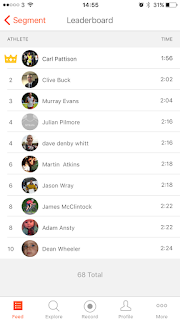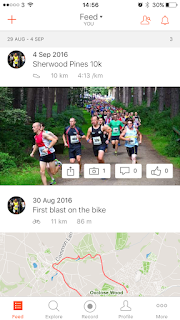The solo runner (me!)
Since I started running in 2014 I've predominantly run alone due to the flexibility that it brings. Family life and a busy job mean that set training opportunities are not a possibility so running alone became a natural response.
Running alone gives me the freedom to get out whenever an opportunity presents itself and also gives me the thinking space I need. You will often read that both of these are common factors for many runners who train alone. I also believe that an additional benefit of training alone is the flexibility of exploring new routes. I might have a set route in my head but could act on instinct and change things mid-run. This has helped me build up a large bank of routes in my local area which cover a variety of distances.
Whilst sticking to solo running, I'm fully aware of the negative aspects, however, I keep these at the forefront of my thoughts so they help spur me on. For example, not pushing hard enough in training: My response to this is to keep a close eye on heart rate. My heart rate monitor clearly tells me if I'm working in the right heart rate zone. If it's been a tough day at the office I have occasionally taken it easy during a run, however it is easy to glance down at my watch to see how hard the ticker is working. Usually this helps me react and lift things but there have also been times when I haven't been able to do this but I don't get too disheartened. It's just the impact of a busy day.
More info on heart rate zones (The link will take you to the detail on this if you require it.)
I also maximise my running opportunities: What I mean by this is that each run has a purpose. I never just go for a run. I might be out on a long run with the main aim of building aerobic capacity with a fast finish or it might be a Fartlek session working on speed sections. I find that having a purpose to each session keeps me working hard whilst helping me progress as a runner.
More info on Fartlek training
Running in groups
Park run time
The closest I get to running in a group is when I enter a race or take part in the local Park run. I'm sure many of you have a Park run nearby or know what they offer. If you haven't heard of it I recommend visiting http://www.parkrun.com/about/. Each Saturday at 9am, the Parkrun takes place at various venues across the country. Once you've registered (for free) and printed your barcode you are ready to go.
For most of us, running is about bettering yourself and not beating other runners. Park run harnesses this approach and gives you a timed event to enable you to see how your 5km PB is going. It isn't a race, but having other runners around you definitely spurs you on to push harder. There are a whole range of running abilities on display with the vast majority of runners embracing the event by fully supporting others.
Some runners aren't too worried about the time and take part to enjoy the experience. For me, I often use the event as a speed session or to see how my 5km time is progressing. At our local Park run they sometimes hold pacers week which I find particularly beneficial to hitting a personal best.
Staying ahead of a pacer guy in a chicken hat helped me get under the 22 minute barrier!
In addition to pushing harder, you also get to have a chat with other runners. People often turn up early to have a chat or warm up which means the event is far more than just a timed 5km run. There is a sense of community about the group and it is clear that it has helped form some strong friendships.
Let's 'Pootle' together
There are many informal groups who meet to run together. They often focus on steady runs that can include everyone. It is clear that this approach could be beneficial to help motivate runners to get out there and maybe help find other like minded runners you could partner up with for other runs. The sense of 'we're in it together' will no doubt help keep you motivated and possibly add a social dimension to your running.
One key factor about these groups is that they are often inclusive which allows everyone to run with others no matter what level they are at. I know that I was quite cautious about attending a group run as I thought I'd be the slowest there and would feel silly. I can promise you that this does not happen in these groups. It's quite the opposite.
My local group Pootle Facebook page meet on monthly basis and have also included effort sessions during the week to add extra impact. I believe that this offers an ideal setup for those runners wanting to run with others without the need to join a local athletics/running club.
Joining a running/athletics club might be what you need to take you to the next level. I've considered it a few times but as I stated at the beginning, it would be hard to fit training sessions into my working week and I've become so accustomed to training alone. I can't add much about running in a club but I'm sure that the structured training sessions and access to skilled coaches would bring many benefits.
In summary, I believe that a mixture of solo and group running would benefit us all. I've become so used to running alone that it feels safe and I've always had the motivation to keep going. I feel I'm at a point where group running could help me improve at a faster rate but I can't see it fitting into my lifestyle at the moment. I'm happy flying solo and browsing YouTube for advice and coaching. I hope this has given you a glimpse into solo and group running and would love to hear your thoughts about the topic in the comments below.








